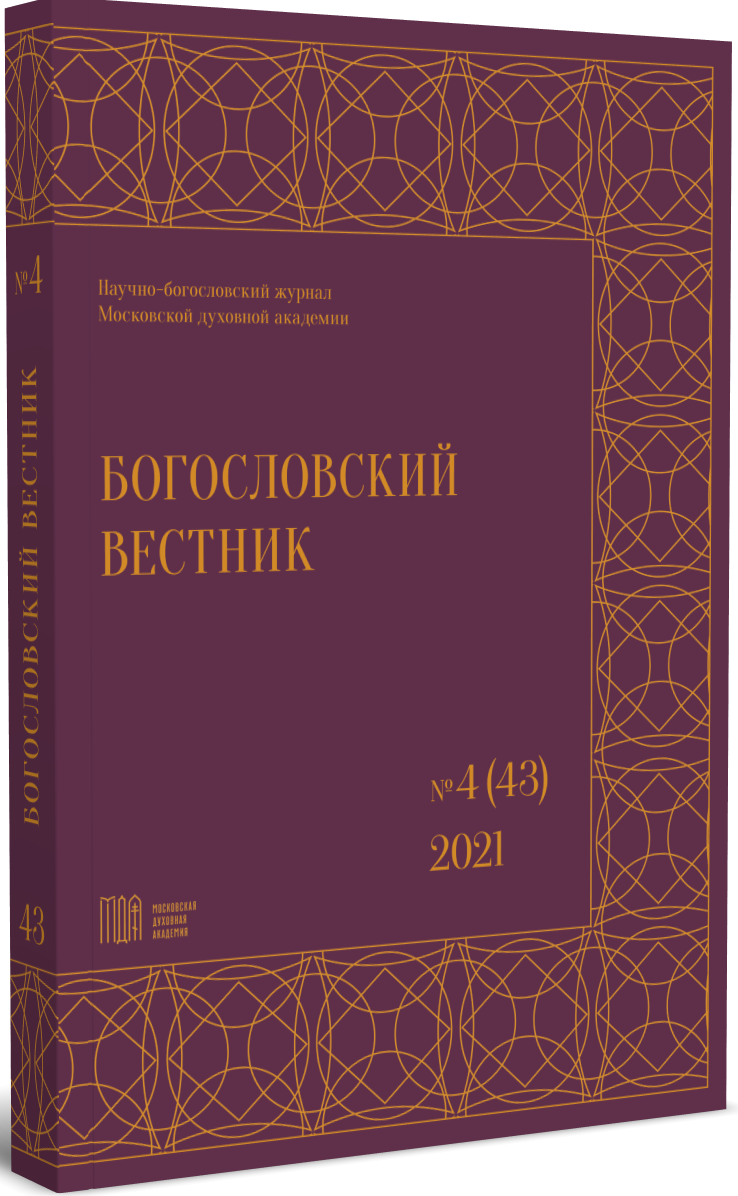The Doctrine of Incessant Penthos of St. Symeon the New Theologian and St. Niketas Stethatos
DOI:
https://doi.org/10.31802/GB.2021.43.4.008Keywords:
sadness, Penthos, tears, Monastery of Stoudios, joy, purification, contemplation, deificationAbstract
The article reveals the doctrine of the incessant penthos of St. Symeon the New Theologian and his disciple St. Niketas Stethatos. This teaching is one of the key leitmotifs, the origins of which we find in St. Simeon the Pious and, more broadly, in the Studian monastic tradition. For St. Symeon the New Theologian, constant crying is a high state of the ascetic who, through purifying himself, has achieved the correct contemplation of the world around him and the vision of God. Crying and tears are not a characteristic feature of sorrow, but of spiritual joy, of being part of the grace-filled gifts of the Holy Spirit. Venerable Niketas Stethatos briefly repeats the main theses of St. Symeon with a certain degree of detail and in relation to the ancient tradition, according to which crying and tears are a manifestation of sadness, which, according to the New Testament formulation, can be «sadness for God» or «sadness of the world». The correlation of the teaching on crying and tears with the ancient, predominantly Stoic, tradition is characteristic of St. Niketas, who also taught about the four main virtues and passions.
Downloads
References
Apophthegmata patrum (collectio systematica) (cap. 10–16) // Les apophtegmes des pères. Collection systématique, chapitres X–XVI / éd. J.-C. Guy. Paris: Éditions du Cerf, 2003. (SC; vol. 474). P. 14–416.
Barsanuphius, Joannes. Quaestiones et responsiones // Barsanuphe et Jean de Gaza. Correspondance. Tomes I–II / éd. F. Neyt; P. de Angelis-Noah. Paris: Éditions du Cerf, 1997–98. (SC; vols. 426; 427). P. 426:158–344; 427:346–674 (even pages).
Barsanuphius, Joannes. Quaestiones et responsiones ad laicos et episcopos (Epistulae 617–848) // Correspondance (Volume III: Aux laïcs et aux évêques, Lettres 617–848) / éd. F. Neyt; P. de Angelis-Noah. Paris: Éditions du Cerf, 2002. (SC; vol. 468). P. 38–330.
Basilius Caesariensis. Homiliae super Psalmos // PG. T. 29. Сol. 209–494.
Basilius Caesariensis. Asceticon magnum sive Quaestiones (regulae brevius tractatae) // PG. T. 31. Col. 1052–1305.
Evagrius. Practicus (capita centum) // Évagre le Pontique. Traité pratique ou le moine, vol. 2 / éd. A. Guillaumont, C. Guillaumont. Paris: Éditions du Cerf, 1971. (SC; vol. 171). P. 482–542, 546–586, 590–620, 624–712.
Gregorius Nazianzenus. In sanctum baptisma orat. XL // PG. T. 36. Col. 360B–425D.
Gregorius Nyssenus. Dialogus de anima et resurrectione // PG. T. 46. Col. 11–161.
Joannes Chrysostomus. Ad populum Antiochenum (homiliae 1–21) // PG. T. 49. Col. 15–222.
Joannes Chrysostomus. In epistulam II ad Corinthios (homiliae 1–30) // PG. 61. Col. 381–610.
Nicetas Stethatus. Centuria 1–3 // PG. 120. Col. 851–1010.
Nicetas Stethatus. Vita Simeonis Novi Theologici // Un grand mystique byzantin. Vie de Syméon le Nouveau Théologien par Nicétas Stéthatos / éd. I. Hausherr. Rome: Pontificum Institutum Orientalium Studiorum, 1928. (Orientalia Christiana; vol. 12). P. 1–230.
Nicetas Stethatus. Hypotyposis // Parpulov G. R. Toward a History of Byzantine Psalters ca. 850–1350 AD. Plovdiv, 2014. P. 277–301.
Origenes. Scholia in Lucam (fragmenta e cod. Venet. 28) // PG. T. 17. Col. 311–330.
Procopius. Commentarii in Isaiam // PG. T. 87/2. Col. 1817–2717.
Symeon Neotheologus. Capita theologica // Syméon le Nouveau Théologien. Chapitres théologiques, gnostiques et pratiques / éd. J. Darrouzès. Paris: Éditions du Cerf, 1996. (SC; vol. 51bis). P. 40–186, 191.
Symeon Neotheologus. Catecheses 1–34 // Syméon le Nouveau Théologien. Catéchèses / éd. B. Krivochéine, J. Paramelle. Paris: Éditions du Cerf, 1963; 1964; 1965. (SC; vols. 96; 104; 113). P. 1:206–468, 2:12–392; 3:12–302.
Symeon Neotheologus. Hymni // Symeon Neos Theologos. Hymnen / hrsg. A. Kambylis. Berlin; New York: De Gruyter, 1976. (Supplementa Byzantina; Bd. 3). S. 34–462.
Symeon Neotheologus. Orationes ethicae // Syméon le Nouveau Théologien. Traités théologiques et éthiques / éd. J. Darrouzès. Paris: Éditions du Cerf, 1966; 1967. (SC; vols. 122; 129). P. 1:170–440; 2:8–458.
Symeon Neotheologus. Orationes theologicae // Syméon le Nouveau Théologien. Traités théologiques et éthiques / éd. J. Darrouzès. Paris: Éditions du Cerf, 1966. (SC; vol. 122). P. 96–168.
Theodorus Studites. Epistulae // Theodori Studitae Epistulae, vol. 1–2 / hrsg. G. Fatouros. Berlin; Novi Eboraci: De Gruyter, 1992. (Corpus Fontium Historiae Byzantinae. Series Berolinensis; Bd. 31). S. 1:5–187; 2:189–861.
Theodorus Studites. Laudatio in Theophanem Confessorem // Efthymiadis S. Le panégyrique de S. Théophane le Confesseur par S. Théodore Stoudite (BHG 1792b) // Analecta Bollandiana. 1993. Vol. 111. P. 268–284.
Theodorus Studites. Sermones Catecheseos Magnae // S. Patris Nostri Theodori Studitae Magnae Catecheseos Sermones / ed. J. Cozza-Luzi. Rome: Bibliotheca Vaticana et Typi Vaticani, 1888–1905. (Nova Patrum Bibliotheca; vols. 9/2 (Cat. 1–77); 10/1 (Cat. 78–111)). P. 1–217 (Cat. 1–77); 7–151 (Cat. 78–111).
Дионисий (Шлёнов), игум. Образы царской власти в византийской литературе: сравнение «царя» и «плача» у прп. Симеона Нового Богослова и его контекст // БВ. 2015. № 3–4 (18–19). С. 136–167.
Дионисий (Шлёнов), игум. Учение о воскресении души у свв. Симеона Нового Богослова и Никиты Стифата // Преподобный Симеон Новый Богослов и его духовное наследие: Материалы Второй международной патристической конференции Общецерковной аспирантуры и докторантуры имени святых Кирилла и Мефодия. М.: Общецерковная аспирантура и докторантура им. свв. Кирилла и Мефодия, 2017. С. 341–362.
Дионисий (Шлёнов), игум. Принцип «Познай себя» у прп. Никиты Стифата в контексте византийской традиции // БВ. 2018. № 1 (28). С. 96–126.
Дионисий (Шлёнов), игум. Учение прп. Никиты Стифата о «четырех главных добродетелях» в контексте античной и византийской литературы. Ч. 1 // БВ. 2019. № 1 (32). С. 192–231.
Дионисий (Шлёнов), игум. Учение прп. Никиты Стифата о «четырех главных добродетелях» в контексте античной и византийской литературы. Ч. 2 // БВ. 2019. № 2 (33). С. 178–203.
Иларион (Алфеев), иером. Антропология Симеона Нового Богослова. Загорск, 1991. Дисс. канд. богословия.
Макгакин И. (Джон Энтони), свящ. Покаяние как богообщение в «Гимнах божественной любви» преподобного Симеона Нового Богослова // Преподобный Симеон Новый Богослов и его духовное наследие: Материалы Второй международной патристической конференции Общецерковной аспирантуры и докторантуры имени святых Кирилла и Мефодия. М.: Общецерковная аспирантура и докторантура им. свв. Кирилла и Мефодия, 2017. С. 128–145.
Каллист (Уэр), митр. Единство человеческой личности по прп. Симеону Новому Богослову // Преподобный Симеон Новый Богослов и его духовное наследие: Материалы Второй международной патристической конференции Общецерковной аспирантуры и докторантуры имени святых Кирилла и Мефодия. М.: Общецерковная аспирантура и докторантура им. свв. Кирилла и Мефодия, 2017. С. 210–231.
Прассас Д. Седьмое огласительное слово при. Симеона Нового Богослова: заблуждение и страсть привязанности // Преподобный Симеон Новый Богослов и его духовное наследие: Материалы Второй международной патристической конференции Общецерковной аспирантуры и докторантуры имени святых Кирилла и Мефодия. М.: Общецерковная аспирантура и докторантура им. свв. Кирилла и Мефодия, 2017. С. 161–175.
Перцель И. Симеон Новый Богослов и богословие божественной сущности / пер. с англ. Т. А. Щукина под ред. О. Н. Ноговицина // «EINAI: Философия. Религия. Культура». Античная традиция и патристика. 2015. Т. 4. № 1/2 (7/8). С. 374–405.
Bradford D. T. Mystical Process in Isaac the Syrian: Tears, Penthos, and the Physiology of Dispassion // Studies in Spirituality. 2016. Vol. 26. P. 59–104.
Fernández T. Byzantine Tears — a Pseudo-Chrysostomic Fragment on Weeping in the Florilegium Coislinianum // Encyclopedic Trends in Byzantium? 2011. P. 125–142.
Finn D. Resting on Tears: The Trinity, The Sacraments, And Grief in Augustine’s Confessions // Augustiniana. 2017. Vol. 67. P. 171–197.
Hausherr I. Penthos: la doctrine de la componction dans l’orient chrétien. Roma, 1944.
Hunt H. M. Penthos and Repentance in St Symeon the New Theologian // Studia patristica. 2001. Vol. 35. P. 114–120.
Hunt H. M. Joy-Bearing Grief: Tears of Contrition in the Writings of the Early Syrian and Byzantine Fathers. Leiden; Boston (Mass.): Brill, 2004. (The Medieval Mediterranean).
Krueger D. Of Semen and Tears: Senses, Substances, and the Boundaries of the Body in the Gnostic Chapters of Niketas Stethatos // Rituels religieux et sensorialité. Antiquité et Moyen Âge. Milano: Silvano, 2021. S. 417–429.
Leduc F. Penthos et larmes dans l’oeuvre de saint Jean Chrysostome // Proche-Orient chrétien. 1991. Bd. 41. S. 220–257.
Mataya N. Weeping Saints: Severinus of Noricum and the Christian Understanding of Tears // Studia patristica. 2016. Vol. 74. P. 401–412.
Müller B. Der Weg des Weinens: die Tradition des «Penthos» in den Apophthegmata Patrum. Göttingen, 2000.
Olson V. «Woman why Weepest Thou?»: Mary Magdalene, the Virgin Mary and The Transformative Power of Holy Tears in Late Medieval Devotional Painting // Mary Magdalene, Iconographic Studies from the Middle Ages to the Baroque. 2012. P. 361–382.
Oppel C. Vita mortalis: Augustine of Hippo’s Spirituality of Tears // Journal of the Australian Early Medieval Association. 2005. Vol. 1. P. 133–144.
Oppel C. N. A Theology of Tears: From Augustine to the Early Thirteenth Century. [Monash University], 2002.
Ramelli I. L. Tears of Pathos, Repentance and Bliss: Crying and Salvation in Origen and Gregory of Nyssa // Tears in the Graeco-Roman World. 2009. P. 367–396.
Seaford R. Laughter and Tears in Early Greek Literature // Greek Laughter and Tears. Antiquity and After. 2017. S. 27–35.
Shlenov D. Images of Royal Power in Byzantine Ascetic Literature: «King» and «Penthos» in the Works and Background of St. Symeon the New Theologian // Etudes byzantines et post-byzantines. 2019. Ser. NS. Vol. 1. P. 251–274.
Downloads
Published
How to Cite
License

This work is licensed under a Creative Commons Attribution-ShareAlike 4.0 International License.








